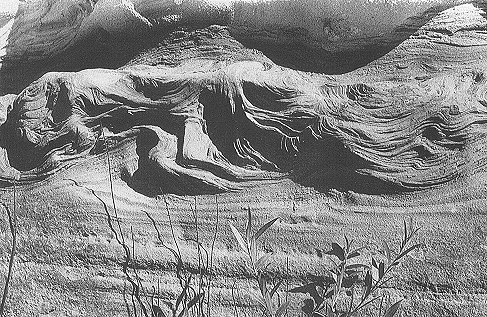
Convolute lamination
Plate 116

Convolute lamination
Plate 116
This structure consists of wavy and contorted sets of laminae occupying a distinct interval in a sandstone/siltstone bed or the bed as a whole. Their salient geometric features are: 1) the deformation does not involve base and top of the convolute interval; convolutions die out toward both boundaries, and are wholly intrastratal features (in contrast with slumpings); 2) the deformation style is entirely ductile, i.e., represented by folding of variable curvature, without any fracture: laminae remain continuous even when they are extremely deformed; 3) antiform folds (convex up curvature) are narrower than synforms, and their hinges have a smaller radius of curvature; 4) axial planes of folds are either vertical or dip upcurrent (convolutions mostly occur in current-laid deposits); 5) in some cases, the convolute laminasets are detached from underlying sediment along a décollement surface, corresponding to a level of weakness (plastic or semifluid material, such as matrix- or vegetal-rich sand).
The above-described features allow the structure to be used as a way-up indicator in tilted successions. From the textural point of view, the convoluted sediment consists of fine sand and silt; clay and vegetal particles can be present, adding cohesion and plasticity. Various proportions of these materials and water make the ductile behavior possible.
The origin of convolute laminae does not seem attributable to a single process. One possibility is that they are produced by water escape; this can be inferred by their frequent association with the structures just described in previous plates. The antiforms would represent escape routes while the synforms would simply be a "passive", complementary record of the deformation. According to another explanation, density contrasts within the laminated packet would put it in gravitational disequilibrium: if denser parts stay on top of less dense ones, the situation is unstable and the packet is solicited to overturn to restore stability. Descending parts (synforms) would be the active ones in this case.
A third interpretation regards the convolutions as a result of current drag. The current from which the sediment was just deposited would keep flowing over it, exerting a shear stress on its surface. Solid friction due to cohesion would drag the ductile laminae down to the depth where the sand reacts more rigidly. This mechanism seems applicable, however, only where the convolution planes are inclined and show a vergence in the current direction.
It is also possible that different processes act together or that each of them is responsible for specific cases. In any case, convolute laminae are not caused by gravity sliding, slumping or creeping, which means that they cannot be used as indicators of paleoslopes.
Marnoso-arenacea Formation, Santerno Valley, northern Apennines.